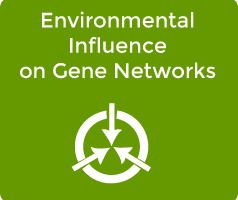View Fullscreen Environmental Influence on Gene Networks
In this module, students complete the steps scientists take when using systems biology to investigate how organisms induce phenotypic changes in response to the environment. Student teams apply their background knowledge of genetics and networks to experiment with a model organism.
Scientists use computer programs and simulations to analyze networks because networks are often very complex. One change in the environment could affect an entire cellular network due to the interdependent nature of networks.
Cellular networks allow cells to respond dynamically to stimuli. A response to a stimulus occurs by changing the relative amount or function of individual nodes in a cellular network. A stimulus affecting one node can cause a change in many other nodes because they are all interconnected in the network.
Students reviewed literature about a model organism (Halo) during Lesson 1 which gave the students an opportunity to investigate the environmental conditions Halo typically grow in. The Lesson 2 laboratory experience will give students an opportunity to actually see the effect of certain environmental variables on the Halobacterium organism.
Students should complete these lessons near the end of a genetics unit. Typically students would have learned that organisms (and individual cells of multicellular organisms) respond to their environment by changing which proteins they make.
In this module, students complete the steps scientists take when using systems biology to investigate how organisms induce phenotypic changes in response to the environment. Student teams apply their background knowledge of genetics and networks to experiment with a model organism.






